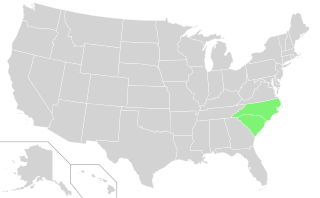Related Research Articles

The Carolina Panthers are a professional American football team based in Charlotte, North Carolina. The Panthers compete in the National Football League (NFL), as a member club of the league's National Football Conference (NFC) South division. The team is headquartered in Bank of America Stadium in Uptown Charlotte; the stadium also serves as the team's home field. The Panthers are supported throughout the Carolinas; although the team has played its home games in Charlotte since 1996, they played their home games at Memorial Stadium in Clemson, South Carolina during its first season. The team hosts its annual training camp at Wofford College in Spartanburg, South Carolina.

North Carolina is a state in the southeastern region of the United States. North Carolina is the 28th largest and 9th-most populous of the 50 United States. It is bordered by Virginia to the north, the Atlantic Ocean to the east, Georgia and South Carolina to the south, and Tennessee to the west. Raleigh is the state's capital and Charlotte is its largest city. The Charlotte metropolitan area, with an estimated population of 2,569,213 in 2018, is the most-populous metropolitan area in North Carolina, the 23rd-most populous in the United States, and the largest banking center in the nation after New York City. The Raleigh metropolitan area is the second-largest metropolitan area in the state, with an estimated population of 1,362,540 in 2018, and is home to the largest research park in the United States, Research Triangle Park.

Charlotte is the most populous city in the U.S. state of North Carolina. Located in the Piedmont, it is the county seat of Mecklenburg County. In 2019, the U.S. Census Bureau estimated the population was 885,708, making it the 15th-most populous city in the U.S. and the second-largest in the Southeast behind Jacksonville, Florida. The city is the cultural, economic, and transportation center of the Charlotte metropolitan area, whose population ranks 23rd in the U.S., and had a population of 2,569,213, in 2018. The Charlotte metropolitan area is part of a sixteen-county market region or combined statistical area with a 2018 census-estimated population of 2,728,933.

Interstate 73 (I-73) is a north–south Interstate Highway, located within the U.S. state of North Carolina. It is part of a longer planned corridor, defined by various federal laws to run from Myrtle Beach, South Carolina, to Sault Ste. Marie, Michigan, but only the part south of West Virginia is under study as of 2012. The corridor passes through the states of South Carolina, North Carolina, Virginia, West Virginia, Ohio, and Michigan. Ohio and Michigan do not plan to build any part of the highway, as the I-73 corridor in both of these states is already served by existing freeways or four-lane highways that will eventually be upgraded to freeways. West Virginia is building its section, mostly along U.S. Highway 52, as a four-lane divided highway, but not meeting the Interstate Highway standards. On the other hand, North Carolina and South Carolina have built sections and Virginia plans to build its part. Thus Interstate 73 will, once scheduled projects are completed, run from South Carolina to Roanoke, Virginia, where it will end at Interstate 81. Associated with these plans are those for the extension of Interstate 74 from Cincinnati to Myrtle Beach, with several highway overlaps contemplated.

The Carolinas are the U.S. states of North Carolina and South Carolina, considered collectively. They are bordered by Virginia to the north, Tennessee to the west, and Georgia to the southwest. The Atlantic Ocean is to the east. Combining North Carolina's population of 10,042,802 and South Carolina's of 4,896,146, the Carolinas have a population of 14,938,948 as of 2015. If the Carolinas were a single state of the United States, it would be the fifth-most populous state, behind California, Texas, Florida, and New York. The Carolinas were known as the Province of Carolina during America's early colonial period, from 1663 to 1710. Prior to that, the land was considered part of the Colony and Dominion of Virginia, from 1609 to 1663. The province, named Carolina to honor King Charles I of England, was divided into two colonies in 1729, although the actual date is the subject of debate.

Scott Wilson Williams is a convicted American serial killer who lived in Monroe, North Carolina. He has been convicted for the murders of three women that took place over a period of nine years. He has also been convicted of crimes against two additional women who were not killed.

The North Carolina Tar Heels football team represents the University of North Carolina at Chapel Hill in the sport of American football. The Tar Heels play in the Football Bowl Subdivision (FBS) of the National Collegiate Athletic Association (NCAA) and the Coastal Division of the Atlantic Coast Conference (ACC).
The Cosmopterigidae are a family of insects in the order Lepidoptera. These are small moths with narrow wings whose tiny larvae feed internally on the leaves, seeds, stems, etc. of their host plants. About 1500 species are described. The taxonomic family is most diverse in the Australian and Pacific region with about 780 species.

The East Carolina Pirates are a college football team that represents East Carolina University. The team is a member of the American Athletic Conference, which is in Division I Football Bowl Subdivision of the National Collegiate Athletic Association (NCAA). Mike Houston is currently the head coach.

The South Carolina Gamecocks football program represents the University of South Carolina in the sport of American football. The Gamecocks compete in the Football Bowl Subdivision of the National Collegiate Athletic Association (NCAA) and the Eastern Division of the Southeastern Conference. Will Muschamp is head coach. They play their home games at Williams-Brice Stadium.

The North Carolina A&T Aggies football program represents North Carolina Agricultural and Technical State University in college football. The Aggies play in NCAA Division I Football Championship Subdivision as a member of the Mid-Eastern Athletic Conference (MEAC).

Paleontology in South Carolina refers to paleontological research occurring within or conducted by people from the U.S. state of South Carolina. Evidence suggests that at least part of South Carolina was covered by a warm, shallow sea and inhabited by trilobites during the Cambrian period. Other than this, little is known about the earliest prehistory of South Carolina because the Ordovician, Silurian, Devonian, Carboniferous, Permian, Triassic, and Jurassic, are missing from the state's local rock record. The earliest fossils of South Carolina date back to the Cretaceous, when the state was partially covered by seawater. Contemporary fossils include marine invertebrates and the remains of dinosaur carcasses that washed out to sea. On land, a wide variety of trees grew. Sea levels rose and fell throughout the ensuing Cenozoic era. Local marine life included invertebrates, fish, sharks, whales. The first scientifically accurate identification of vertebrate fossils in North America occurred in South Carolina. In 1725, African slaves digging in a swamp uncovered mammoth teeth, which they recognized as originating from an elephant-like animal.
Teladoma astigmatica is a moth in the family Cosmopterigidae. It is found in North America, where it has been recorded from western Texas and southern New Mexico.
Teladoma exigua is a moth in the family Cosmopterigidae. It is found in North America, where it has been recorded from California and Arizona.
Teladoma habra is a moth in the family Cosmopterigidae. It is found in North America, where it has been recorded from West Virginia and Arkansas.
Teladoma incana is a moth in the family Cosmopterigidae. It is found in North America, where it has been recorded from Illinois and Arkansas.
Teladoma murina is a moth in the family Cosmopterigidae. It is found in North America, where it has been recorded from Texas and Arizona.
Teladoma nebula is a moth in the family Cosmopterigidae. It is found in North America, where it has been recorded from Arizona.
Teladoma tonia is a moth in the family Cosmopterigidae. It is found in North America, where it has been recorded from Arizona.

The North Carolina A&T–South Carolina State football rivalry is an American college football rivalry game played annually by the Aggies of North Carolina Agricultural and Technical State University and the Bulldogs of South Carolina State University. The series dates back to 1924 and is driven by the proximity of the two schools, as both are within The Carolinas; and conference alignments.
References
| This article relating to Cosmopteriginae is a stub. You can help Wikipedia by expanding it. |